Sustainable Tourism Management and UN Development Goals Report
VerifiedAdded on 2023/04/24
|11
|2292
|186
Report
AI Summary
This report delves into the potential of tourism to drive positive change aligned with the United Nations' Sustainable Development Goals (SDGs). It examines how the tourism industry can contribute to achieving six key SDGs: eradicating poverty (Goal 1) through community engagement and local empowerment; ending hunger and promoting sustainable agriculture (Goal 2) by fostering eco-tourism and organic farming; achieving gender equality and empowering women (Goal 5) by providing employment opportunities; promoting sustainable economic growth and decent work (Goal 8) by reducing emissions and increasing employment; building sustainable infrastructure and fostering innovation (Goal 9) by utilizing natural resources; and conserving oceans and marine resources (Goal 14) through sustainable management practices. The report provides examples from various countries, such as New Zealand, Thailand, Saudi Arabia, Nepal, Bhutan, Australia, and Malaysia, to illustrate the practical applications and positive impacts of sustainable tourism on these goals, emphasizing its role in economic, social, and environmental development.
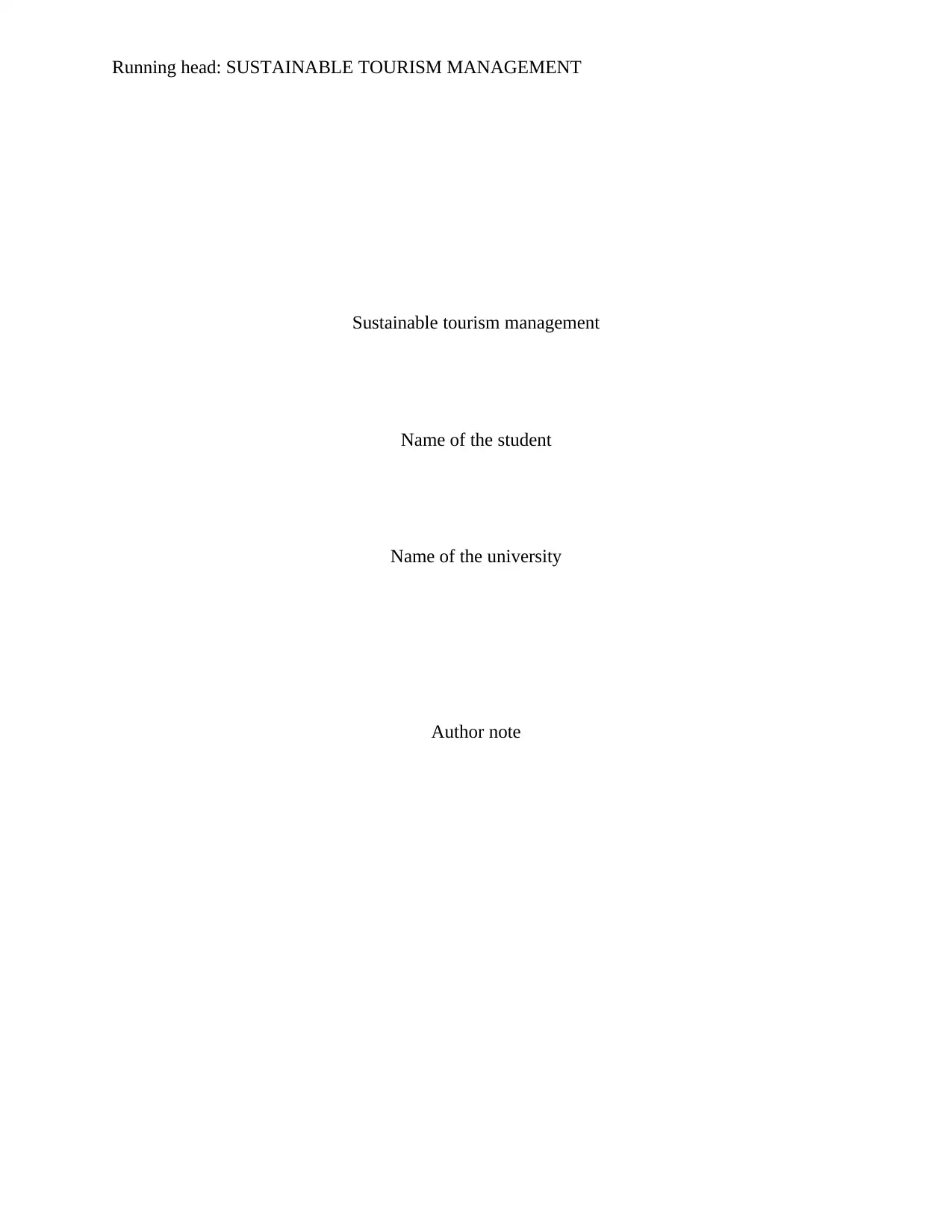
Running head: SUSTAINABLE TOURISM MANAGEMENT
Sustainable tourism management
Name of the student
Name of the university
Author note
Sustainable tourism management
Name of the student
Name of the university
Author note
Paraphrase This Document
Need a fresh take? Get an instant paraphrase of this document with our AI Paraphraser

1SUSTAINABLE TOURISM MANAGEMENT
Introduction
Tourism is being considered as one of the largest and emerging industries in the recent
time with having their potentiality across the word and in every location. Moreover, with the
increase in the global traffic of tourists among different countries, tourism industry is becoming
one of the biggest employers and revenue generators in the world. Thus, due to becoming the
leading industry in the world, tourism industry is also having the responsibility towards gaining
sustainability in the long term (Griggs et al., 2013). In this case, the sustainable development
goals stated by the United Nations should be followed by the tourism industry in creating
positive change. Tourism industry will find it easier in aligning with these goals due to the
reason that they are leveraging on the ecological factors in generating revenue. Furthermore,
tourism sector is having larger influence to the root level and empowers from the lower section
of the societies (Nilsson, Griggs & Visbeck, 2016). Thus, the sustainable development goals can
be ideally applied in the case of tourism industry.
This essay will discuss about how the tourism industry can create positive change in
terms of the sustainable development goals and the extent to which the long term sustainability
will be gained.
Goal 1
Goal 1 of the sustainable development goals states about the importance of mitigating
poverty in all its forms. In this case, the major role of the tourism industry will be to engage and
empower larger social sections in their process. This is due to the reason that currently there are
number of destinations across the world where home stay concept is practiced (Nam, 2015). This
refers to the providence of authentic local taste and cultures to the tourists by letting them stay
Introduction
Tourism is being considered as one of the largest and emerging industries in the recent
time with having their potentiality across the word and in every location. Moreover, with the
increase in the global traffic of tourists among different countries, tourism industry is becoming
one of the biggest employers and revenue generators in the world. Thus, due to becoming the
leading industry in the world, tourism industry is also having the responsibility towards gaining
sustainability in the long term (Griggs et al., 2013). In this case, the sustainable development
goals stated by the United Nations should be followed by the tourism industry in creating
positive change. Tourism industry will find it easier in aligning with these goals due to the
reason that they are leveraging on the ecological factors in generating revenue. Furthermore,
tourism sector is having larger influence to the root level and empowers from the lower section
of the societies (Nilsson, Griggs & Visbeck, 2016). Thus, the sustainable development goals can
be ideally applied in the case of tourism industry.
This essay will discuss about how the tourism industry can create positive change in
terms of the sustainable development goals and the extent to which the long term sustainability
will be gained.
Goal 1
Goal 1 of the sustainable development goals states about the importance of mitigating
poverty in all its forms. In this case, the major role of the tourism industry will be to engage and
empower larger social sections in their process. This is due to the reason that currently there are
number of destinations across the world where home stay concept is practiced (Nam, 2015). This
refers to the providence of authentic local taste and cultures to the tourists by letting them stay
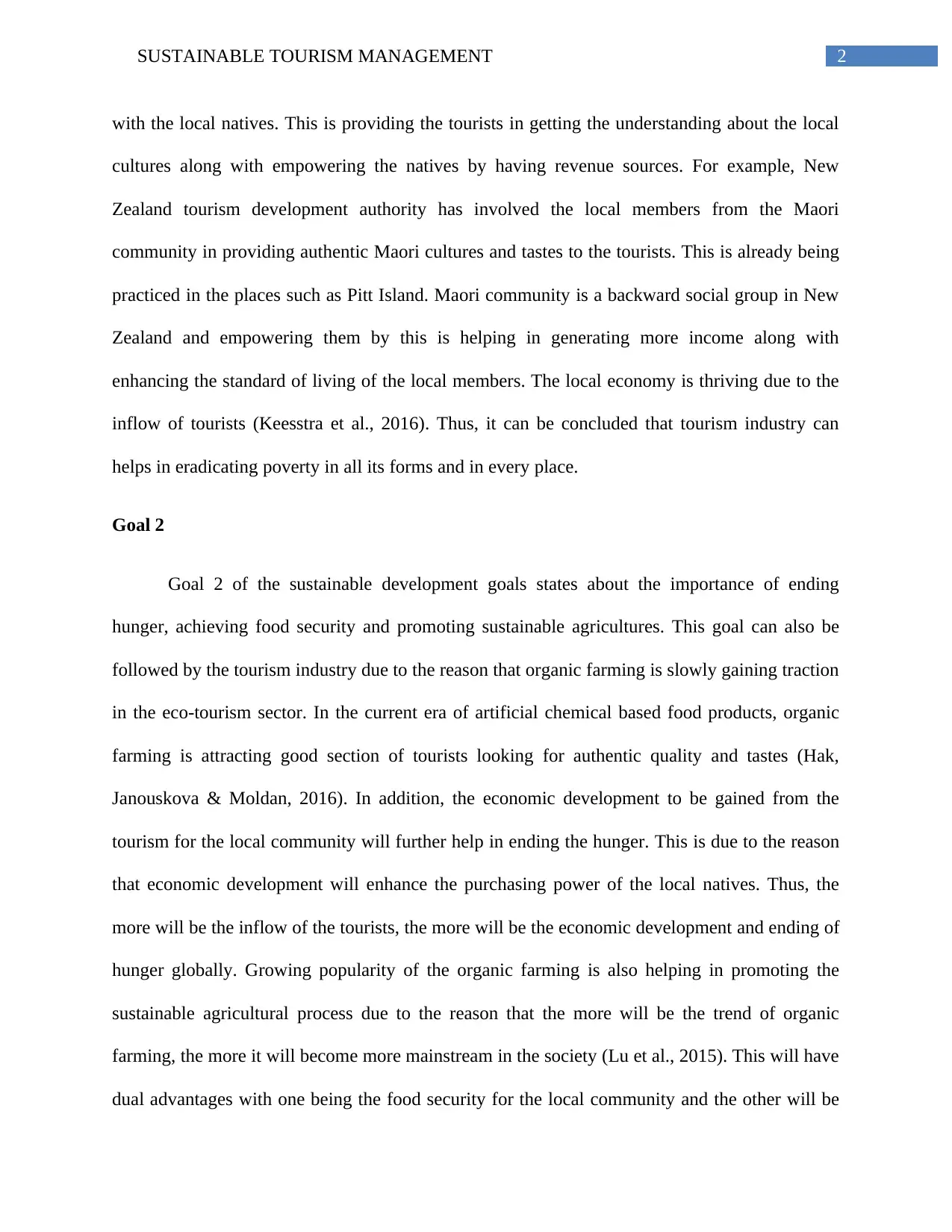
2SUSTAINABLE TOURISM MANAGEMENT
with the local natives. This is providing the tourists in getting the understanding about the local
cultures along with empowering the natives by having revenue sources. For example, New
Zealand tourism development authority has involved the local members from the Maori
community in providing authentic Maori cultures and tastes to the tourists. This is already being
practiced in the places such as Pitt Island. Maori community is a backward social group in New
Zealand and empowering them by this is helping in generating more income along with
enhancing the standard of living of the local members. The local economy is thriving due to the
inflow of tourists (Keesstra et al., 2016). Thus, it can be concluded that tourism industry can
helps in eradicating poverty in all its forms and in every place.
Goal 2
Goal 2 of the sustainable development goals states about the importance of ending
hunger, achieving food security and promoting sustainable agricultures. This goal can also be
followed by the tourism industry due to the reason that organic farming is slowly gaining traction
in the eco-tourism sector. In the current era of artificial chemical based food products, organic
farming is attracting good section of tourists looking for authentic quality and tastes (Hak,
Janouskova & Moldan, 2016). In addition, the economic development to be gained from the
tourism for the local community will further help in ending the hunger. This is due to the reason
that economic development will enhance the purchasing power of the local natives. Thus, the
more will be the inflow of the tourists, the more will be the economic development and ending of
hunger globally. Growing popularity of the organic farming is also helping in promoting the
sustainable agricultural process due to the reason that the more will be the trend of organic
farming, the more it will become more mainstream in the society (Lu et al., 2015). This will have
dual advantages with one being the food security for the local community and the other will be
with the local natives. This is providing the tourists in getting the understanding about the local
cultures along with empowering the natives by having revenue sources. For example, New
Zealand tourism development authority has involved the local members from the Maori
community in providing authentic Maori cultures and tastes to the tourists. This is already being
practiced in the places such as Pitt Island. Maori community is a backward social group in New
Zealand and empowering them by this is helping in generating more income along with
enhancing the standard of living of the local members. The local economy is thriving due to the
inflow of tourists (Keesstra et al., 2016). Thus, it can be concluded that tourism industry can
helps in eradicating poverty in all its forms and in every place.
Goal 2
Goal 2 of the sustainable development goals states about the importance of ending
hunger, achieving food security and promoting sustainable agricultures. This goal can also be
followed by the tourism industry due to the reason that organic farming is slowly gaining traction
in the eco-tourism sector. In the current era of artificial chemical based food products, organic
farming is attracting good section of tourists looking for authentic quality and tastes (Hak,
Janouskova & Moldan, 2016). In addition, the economic development to be gained from the
tourism for the local community will further help in ending the hunger. This is due to the reason
that economic development will enhance the purchasing power of the local natives. Thus, the
more will be the inflow of the tourists, the more will be the economic development and ending of
hunger globally. Growing popularity of the organic farming is also helping in promoting the
sustainable agricultural process due to the reason that the more will be the trend of organic
farming, the more it will become more mainstream in the society (Lu et al., 2015). This will have
dual advantages with one being the food security for the local community and the other will be
⊘ This is a preview!⊘
Do you want full access?
Subscribe today to unlock all pages.

Trusted by 1+ million students worldwide
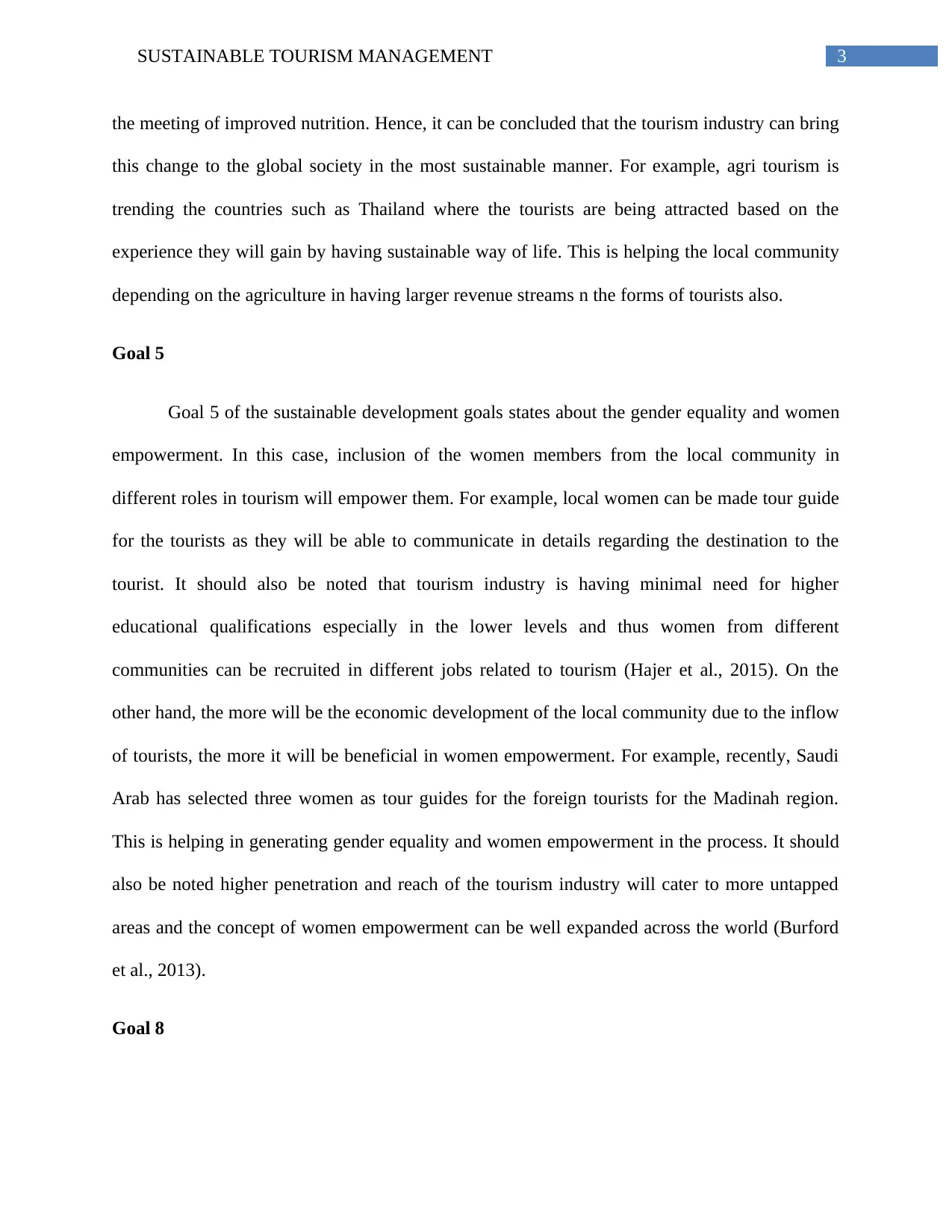
3SUSTAINABLE TOURISM MANAGEMENT
the meeting of improved nutrition. Hence, it can be concluded that the tourism industry can bring
this change to the global society in the most sustainable manner. For example, agri tourism is
trending the countries such as Thailand where the tourists are being attracted based on the
experience they will gain by having sustainable way of life. This is helping the local community
depending on the agriculture in having larger revenue streams n the forms of tourists also.
Goal 5
Goal 5 of the sustainable development goals states about the gender equality and women
empowerment. In this case, inclusion of the women members from the local community in
different roles in tourism will empower them. For example, local women can be made tour guide
for the tourists as they will be able to communicate in details regarding the destination to the
tourist. It should also be noted that tourism industry is having minimal need for higher
educational qualifications especially in the lower levels and thus women from different
communities can be recruited in different jobs related to tourism (Hajer et al., 2015). On the
other hand, the more will be the economic development of the local community due to the inflow
of tourists, the more it will be beneficial in women empowerment. For example, recently, Saudi
Arab has selected three women as tour guides for the foreign tourists for the Madinah region.
This is helping in generating gender equality and women empowerment in the process. It should
also be noted higher penetration and reach of the tourism industry will cater to more untapped
areas and the concept of women empowerment can be well expanded across the world (Burford
et al., 2013).
Goal 8
the meeting of improved nutrition. Hence, it can be concluded that the tourism industry can bring
this change to the global society in the most sustainable manner. For example, agri tourism is
trending the countries such as Thailand where the tourists are being attracted based on the
experience they will gain by having sustainable way of life. This is helping the local community
depending on the agriculture in having larger revenue streams n the forms of tourists also.
Goal 5
Goal 5 of the sustainable development goals states about the gender equality and women
empowerment. In this case, inclusion of the women members from the local community in
different roles in tourism will empower them. For example, local women can be made tour guide
for the tourists as they will be able to communicate in details regarding the destination to the
tourist. It should also be noted that tourism industry is having minimal need for higher
educational qualifications especially in the lower levels and thus women from different
communities can be recruited in different jobs related to tourism (Hajer et al., 2015). On the
other hand, the more will be the economic development of the local community due to the inflow
of tourists, the more it will be beneficial in women empowerment. For example, recently, Saudi
Arab has selected three women as tour guides for the foreign tourists for the Madinah region.
This is helping in generating gender equality and women empowerment in the process. It should
also be noted higher penetration and reach of the tourism industry will cater to more untapped
areas and the concept of women empowerment can be well expanded across the world (Burford
et al., 2013).
Goal 8
Paraphrase This Document
Need a fresh take? Get an instant paraphrase of this document with our AI Paraphraser
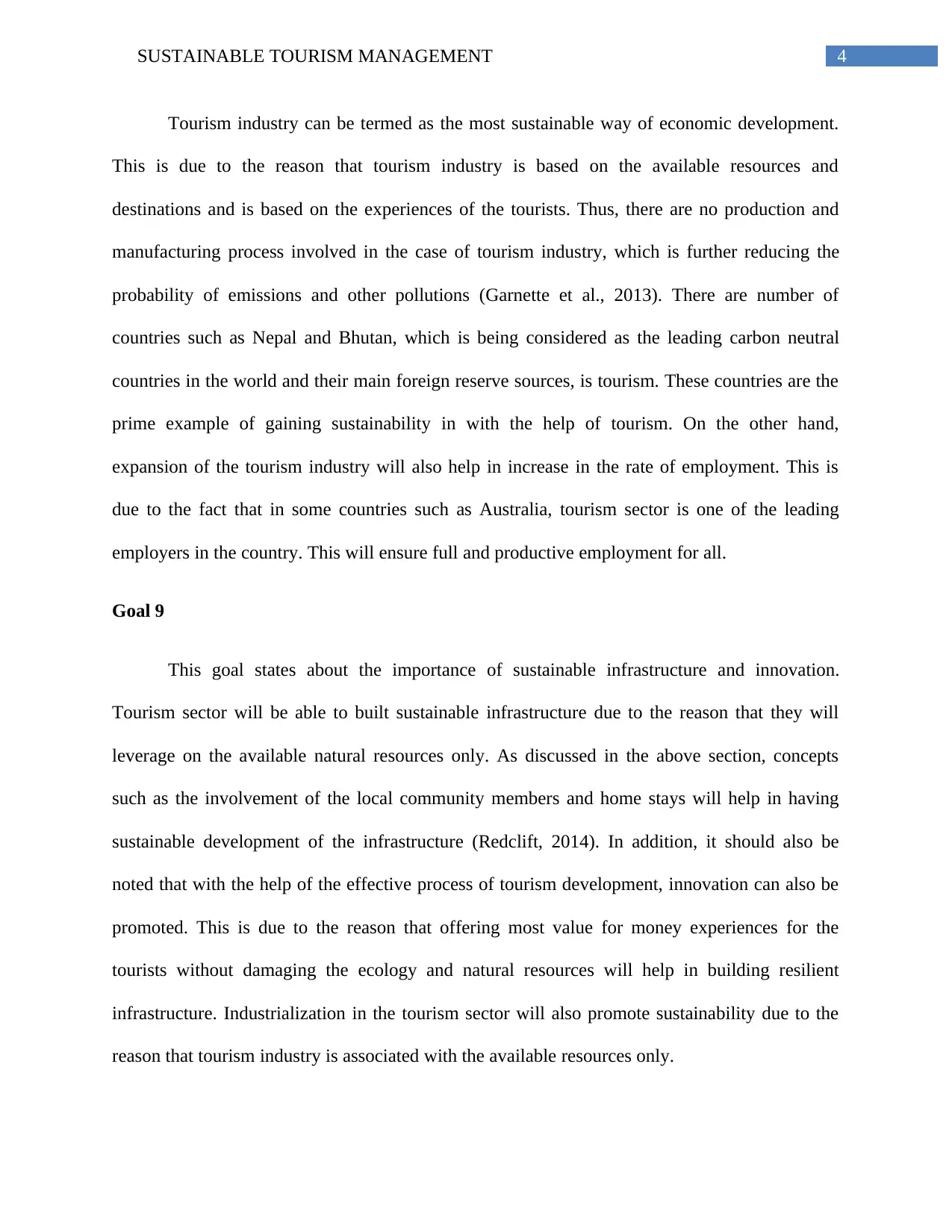
4SUSTAINABLE TOURISM MANAGEMENT
Tourism industry can be termed as the most sustainable way of economic development.
This is due to the reason that tourism industry is based on the available resources and
destinations and is based on the experiences of the tourists. Thus, there are no production and
manufacturing process involved in the case of tourism industry, which is further reducing the
probability of emissions and other pollutions (Garnette et al., 2013). There are number of
countries such as Nepal and Bhutan, which is being considered as the leading carbon neutral
countries in the world and their main foreign reserve sources, is tourism. These countries are the
prime example of gaining sustainability in with the help of tourism. On the other hand,
expansion of the tourism industry will also help in increase in the rate of employment. This is
due to the fact that in some countries such as Australia, tourism sector is one of the leading
employers in the country. This will ensure full and productive employment for all.
Goal 9
This goal states about the importance of sustainable infrastructure and innovation.
Tourism sector will be able to built sustainable infrastructure due to the reason that they will
leverage on the available natural resources only. As discussed in the above section, concepts
such as the involvement of the local community members and home stays will help in having
sustainable development of the infrastructure (Redclift, 2014). In addition, it should also be
noted that with the help of the effective process of tourism development, innovation can also be
promoted. This is due to the reason that offering most value for money experiences for the
tourists without damaging the ecology and natural resources will help in building resilient
infrastructure. Industrialization in the tourism sector will also promote sustainability due to the
reason that tourism industry is associated with the available resources only.
Tourism industry can be termed as the most sustainable way of economic development.
This is due to the reason that tourism industry is based on the available resources and
destinations and is based on the experiences of the tourists. Thus, there are no production and
manufacturing process involved in the case of tourism industry, which is further reducing the
probability of emissions and other pollutions (Garnette et al., 2013). There are number of
countries such as Nepal and Bhutan, which is being considered as the leading carbon neutral
countries in the world and their main foreign reserve sources, is tourism. These countries are the
prime example of gaining sustainability in with the help of tourism. On the other hand,
expansion of the tourism industry will also help in increase in the rate of employment. This is
due to the fact that in some countries such as Australia, tourism sector is one of the leading
employers in the country. This will ensure full and productive employment for all.
Goal 9
This goal states about the importance of sustainable infrastructure and innovation.
Tourism sector will be able to built sustainable infrastructure due to the reason that they will
leverage on the available natural resources only. As discussed in the above section, concepts
such as the involvement of the local community members and home stays will help in having
sustainable development of the infrastructure (Redclift, 2014). In addition, it should also be
noted that with the help of the effective process of tourism development, innovation can also be
promoted. This is due to the reason that offering most value for money experiences for the
tourists without damaging the ecology and natural resources will help in building resilient
infrastructure. Industrialization in the tourism sector will also promote sustainability due to the
reason that tourism industry is associated with the available resources only.
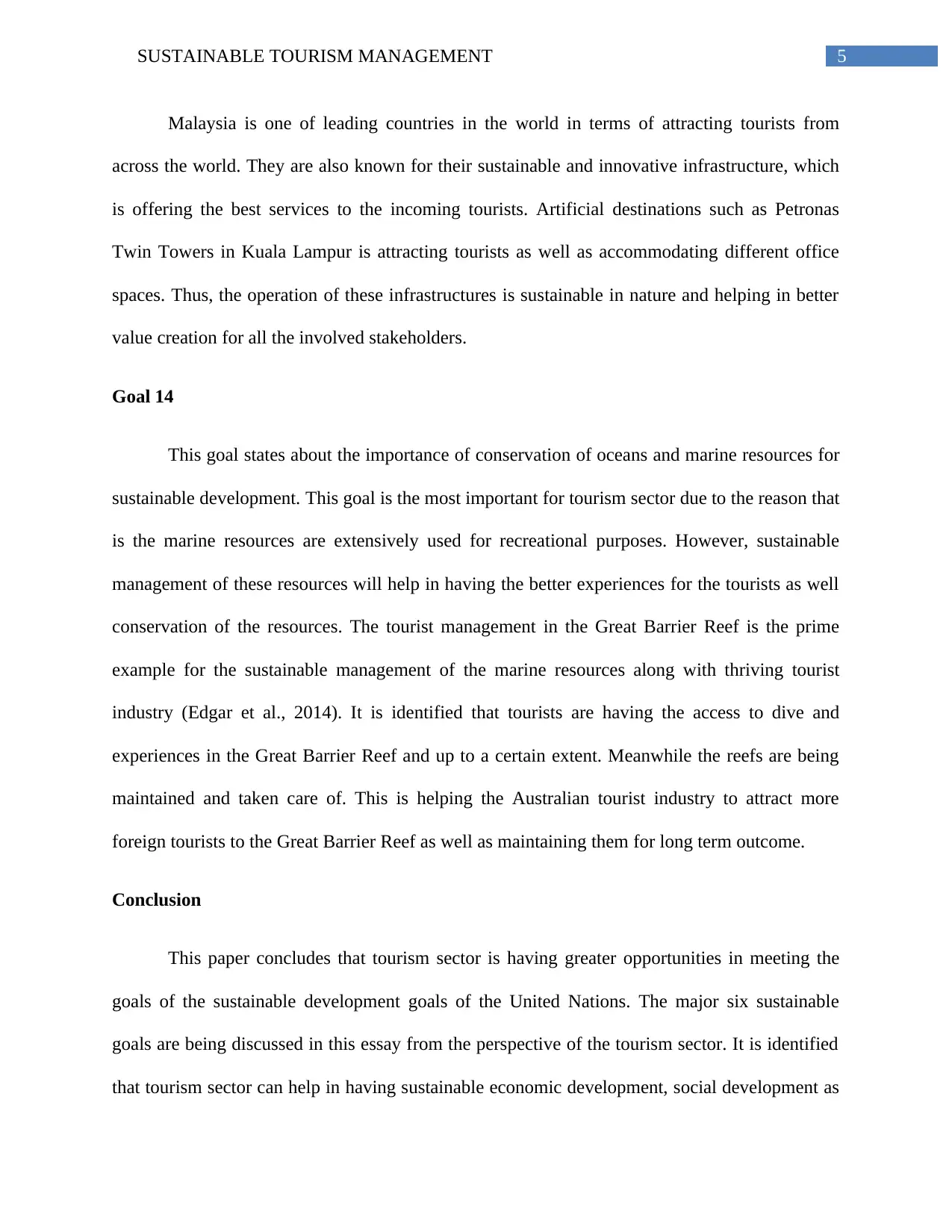
5SUSTAINABLE TOURISM MANAGEMENT
Malaysia is one of leading countries in the world in terms of attracting tourists from
across the world. They are also known for their sustainable and innovative infrastructure, which
is offering the best services to the incoming tourists. Artificial destinations such as Petronas
Twin Towers in Kuala Lampur is attracting tourists as well as accommodating different office
spaces. Thus, the operation of these infrastructures is sustainable in nature and helping in better
value creation for all the involved stakeholders.
Goal 14
This goal states about the importance of conservation of oceans and marine resources for
sustainable development. This goal is the most important for tourism sector due to the reason that
is the marine resources are extensively used for recreational purposes. However, sustainable
management of these resources will help in having the better experiences for the tourists as well
conservation of the resources. The tourist management in the Great Barrier Reef is the prime
example for the sustainable management of the marine resources along with thriving tourist
industry (Edgar et al., 2014). It is identified that tourists are having the access to dive and
experiences in the Great Barrier Reef and up to a certain extent. Meanwhile the reefs are being
maintained and taken care of. This is helping the Australian tourist industry to attract more
foreign tourists to the Great Barrier Reef as well as maintaining them for long term outcome.
Conclusion
This paper concludes that tourism sector is having greater opportunities in meeting the
goals of the sustainable development goals of the United Nations. The major six sustainable
goals are being discussed in this essay from the perspective of the tourism sector. It is identified
that tourism sector can help in having sustainable economic development, social development as
Malaysia is one of leading countries in the world in terms of attracting tourists from
across the world. They are also known for their sustainable and innovative infrastructure, which
is offering the best services to the incoming tourists. Artificial destinations such as Petronas
Twin Towers in Kuala Lampur is attracting tourists as well as accommodating different office
spaces. Thus, the operation of these infrastructures is sustainable in nature and helping in better
value creation for all the involved stakeholders.
Goal 14
This goal states about the importance of conservation of oceans and marine resources for
sustainable development. This goal is the most important for tourism sector due to the reason that
is the marine resources are extensively used for recreational purposes. However, sustainable
management of these resources will help in having the better experiences for the tourists as well
conservation of the resources. The tourist management in the Great Barrier Reef is the prime
example for the sustainable management of the marine resources along with thriving tourist
industry (Edgar et al., 2014). It is identified that tourists are having the access to dive and
experiences in the Great Barrier Reef and up to a certain extent. Meanwhile the reefs are being
maintained and taken care of. This is helping the Australian tourist industry to attract more
foreign tourists to the Great Barrier Reef as well as maintaining them for long term outcome.
Conclusion
This paper concludes that tourism sector is having greater opportunities in meeting the
goals of the sustainable development goals of the United Nations. The major six sustainable
goals are being discussed in this essay from the perspective of the tourism sector. It is identified
that tourism sector can help in having sustainable economic development, social development as
⊘ This is a preview!⊘
Do you want full access?
Subscribe today to unlock all pages.

Trusted by 1+ million students worldwide
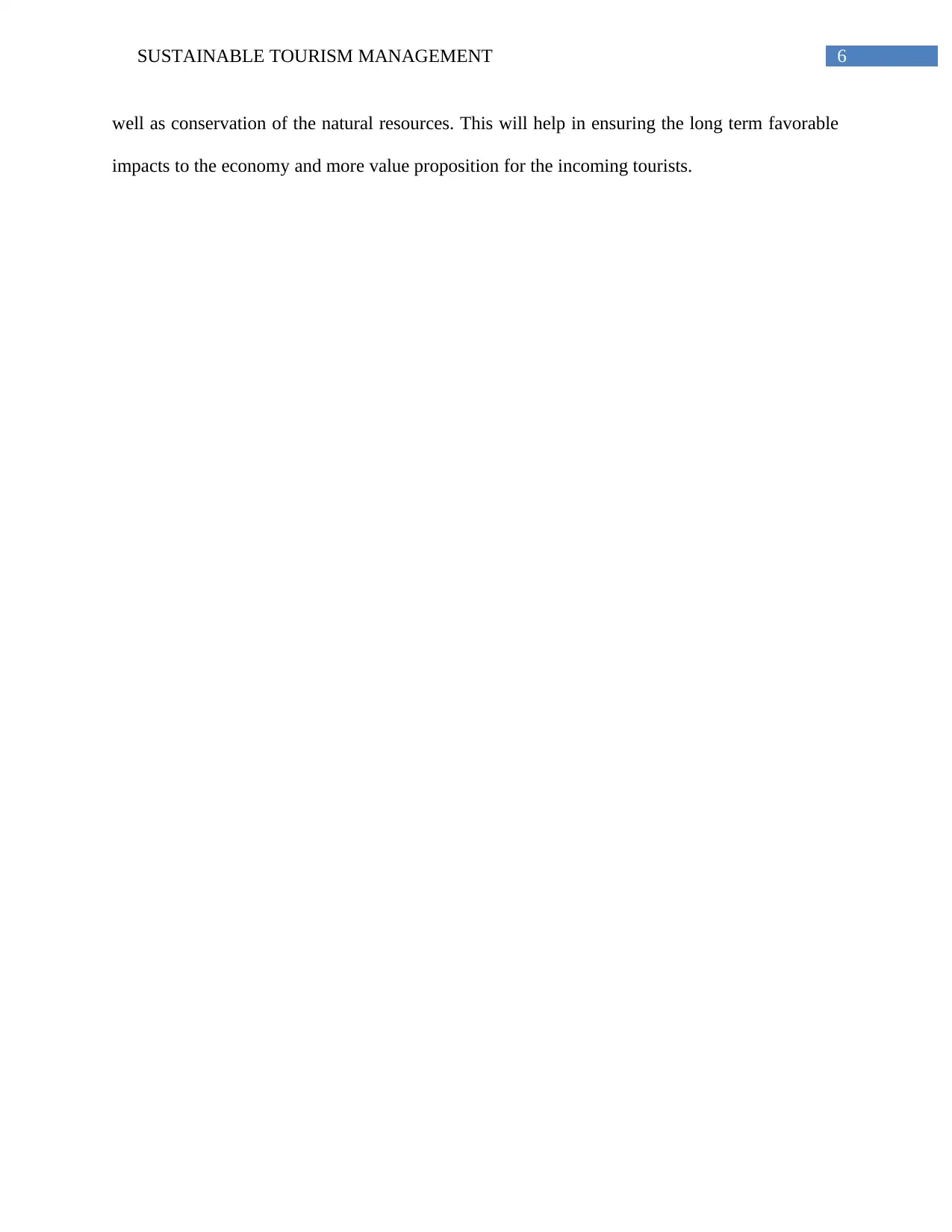
6SUSTAINABLE TOURISM MANAGEMENT
well as conservation of the natural resources. This will help in ensuring the long term favorable
impacts to the economy and more value proposition for the incoming tourists.
well as conservation of the natural resources. This will help in ensuring the long term favorable
impacts to the economy and more value proposition for the incoming tourists.
Paraphrase This Document
Need a fresh take? Get an instant paraphrase of this document with our AI Paraphraser
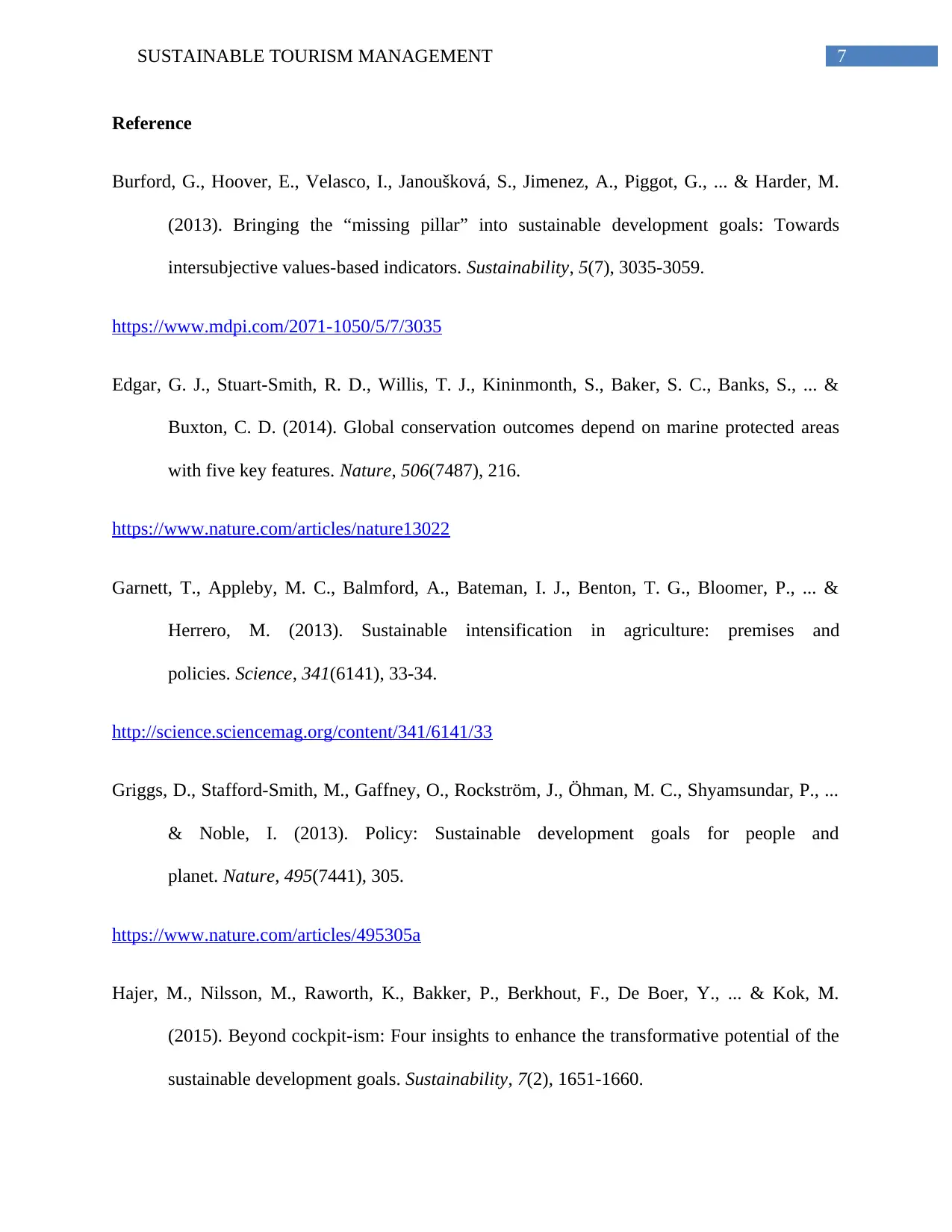
7SUSTAINABLE TOURISM MANAGEMENT
Reference
Burford, G., Hoover, E., Velasco, I., Janoušková, S., Jimenez, A., Piggot, G., ... & Harder, M.
(2013). Bringing the “missing pillar” into sustainable development goals: Towards
intersubjective values-based indicators. Sustainability, 5(7), 3035-3059.
https://www.mdpi.com/2071-1050/5/7/3035
Edgar, G. J., Stuart-Smith, R. D., Willis, T. J., Kininmonth, S., Baker, S. C., Banks, S., ... &
Buxton, C. D. (2014). Global conservation outcomes depend on marine protected areas
with five key features. Nature, 506(7487), 216.
https://www.nature.com/articles/nature13022
Garnett, T., Appleby, M. C., Balmford, A., Bateman, I. J., Benton, T. G., Bloomer, P., ... &
Herrero, M. (2013). Sustainable intensification in agriculture: premises and
policies. Science, 341(6141), 33-34.
http://science.sciencemag.org/content/341/6141/33
Griggs, D., Stafford-Smith, M., Gaffney, O., Rockström, J., Öhman, M. C., Shyamsundar, P., ...
& Noble, I. (2013). Policy: Sustainable development goals for people and
planet. Nature, 495(7441), 305.
https://www.nature.com/articles/495305a
Hajer, M., Nilsson, M., Raworth, K., Bakker, P., Berkhout, F., De Boer, Y., ... & Kok, M.
(2015). Beyond cockpit-ism: Four insights to enhance the transformative potential of the
sustainable development goals. Sustainability, 7(2), 1651-1660.
Reference
Burford, G., Hoover, E., Velasco, I., Janoušková, S., Jimenez, A., Piggot, G., ... & Harder, M.
(2013). Bringing the “missing pillar” into sustainable development goals: Towards
intersubjective values-based indicators. Sustainability, 5(7), 3035-3059.
https://www.mdpi.com/2071-1050/5/7/3035
Edgar, G. J., Stuart-Smith, R. D., Willis, T. J., Kininmonth, S., Baker, S. C., Banks, S., ... &
Buxton, C. D. (2014). Global conservation outcomes depend on marine protected areas
with five key features. Nature, 506(7487), 216.
https://www.nature.com/articles/nature13022
Garnett, T., Appleby, M. C., Balmford, A., Bateman, I. J., Benton, T. G., Bloomer, P., ... &
Herrero, M. (2013). Sustainable intensification in agriculture: premises and
policies. Science, 341(6141), 33-34.
http://science.sciencemag.org/content/341/6141/33
Griggs, D., Stafford-Smith, M., Gaffney, O., Rockström, J., Öhman, M. C., Shyamsundar, P., ...
& Noble, I. (2013). Policy: Sustainable development goals for people and
planet. Nature, 495(7441), 305.
https://www.nature.com/articles/495305a
Hajer, M., Nilsson, M., Raworth, K., Bakker, P., Berkhout, F., De Boer, Y., ... & Kok, M.
(2015). Beyond cockpit-ism: Four insights to enhance the transformative potential of the
sustainable development goals. Sustainability, 7(2), 1651-1660.
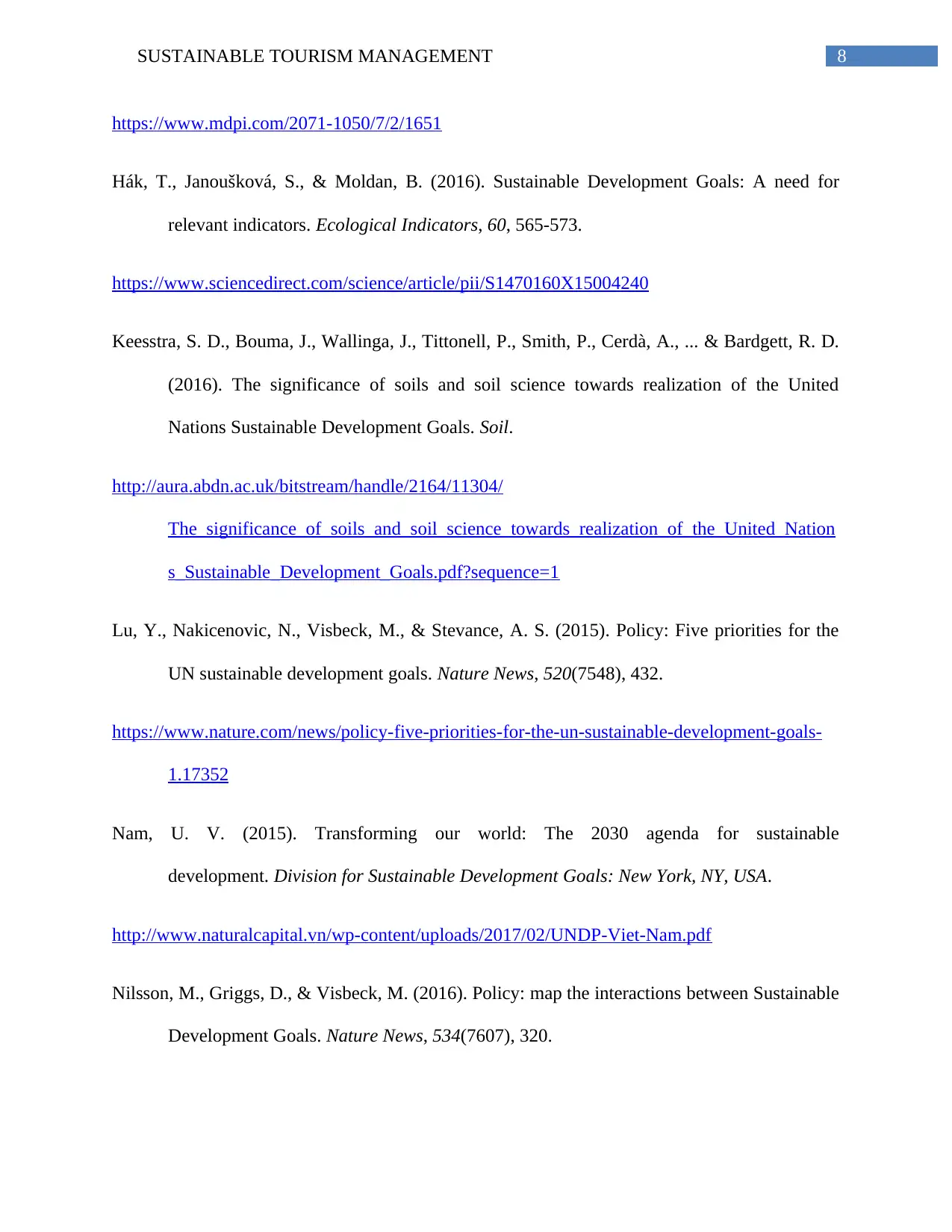
8SUSTAINABLE TOURISM MANAGEMENT
https://www.mdpi.com/2071-1050/7/2/1651
Hák, T., Janoušková, S., & Moldan, B. (2016). Sustainable Development Goals: A need for
relevant indicators. Ecological Indicators, 60, 565-573.
https://www.sciencedirect.com/science/article/pii/S1470160X15004240
Keesstra, S. D., Bouma, J., Wallinga, J., Tittonell, P., Smith, P., Cerdà, A., ... & Bardgett, R. D.
(2016). The significance of soils and soil science towards realization of the United
Nations Sustainable Development Goals. Soil.
http://aura.abdn.ac.uk/bitstream/handle/2164/11304/
The_significance_of_soils_and_soil_science_towards_realization_of_the_United_Nation
s_Sustainable_Development_Goals.pdf?sequence=1
Lu, Y., Nakicenovic, N., Visbeck, M., & Stevance, A. S. (2015). Policy: Five priorities for the
UN sustainable development goals. Nature News, 520(7548), 432.
https://www.nature.com/news/policy-five-priorities-for-the-un-sustainable-development-goals-
1.17352
Nam, U. V. (2015). Transforming our world: The 2030 agenda for sustainable
development. Division for Sustainable Development Goals: New York, NY, USA.
http://www.naturalcapital.vn/wp-content/uploads/2017/02/UNDP-Viet-Nam.pdf
Nilsson, M., Griggs, D., & Visbeck, M. (2016). Policy: map the interactions between Sustainable
Development Goals. Nature News, 534(7607), 320.
https://www.mdpi.com/2071-1050/7/2/1651
Hák, T., Janoušková, S., & Moldan, B. (2016). Sustainable Development Goals: A need for
relevant indicators. Ecological Indicators, 60, 565-573.
https://www.sciencedirect.com/science/article/pii/S1470160X15004240
Keesstra, S. D., Bouma, J., Wallinga, J., Tittonell, P., Smith, P., Cerdà, A., ... & Bardgett, R. D.
(2016). The significance of soils and soil science towards realization of the United
Nations Sustainable Development Goals. Soil.
http://aura.abdn.ac.uk/bitstream/handle/2164/11304/
The_significance_of_soils_and_soil_science_towards_realization_of_the_United_Nation
s_Sustainable_Development_Goals.pdf?sequence=1
Lu, Y., Nakicenovic, N., Visbeck, M., & Stevance, A. S. (2015). Policy: Five priorities for the
UN sustainable development goals. Nature News, 520(7548), 432.
https://www.nature.com/news/policy-five-priorities-for-the-un-sustainable-development-goals-
1.17352
Nam, U. V. (2015). Transforming our world: The 2030 agenda for sustainable
development. Division for Sustainable Development Goals: New York, NY, USA.
http://www.naturalcapital.vn/wp-content/uploads/2017/02/UNDP-Viet-Nam.pdf
Nilsson, M., Griggs, D., & Visbeck, M. (2016). Policy: map the interactions between Sustainable
Development Goals. Nature News, 534(7607), 320.
⊘ This is a preview!⊘
Do you want full access?
Subscribe today to unlock all pages.

Trusted by 1+ million students worldwide
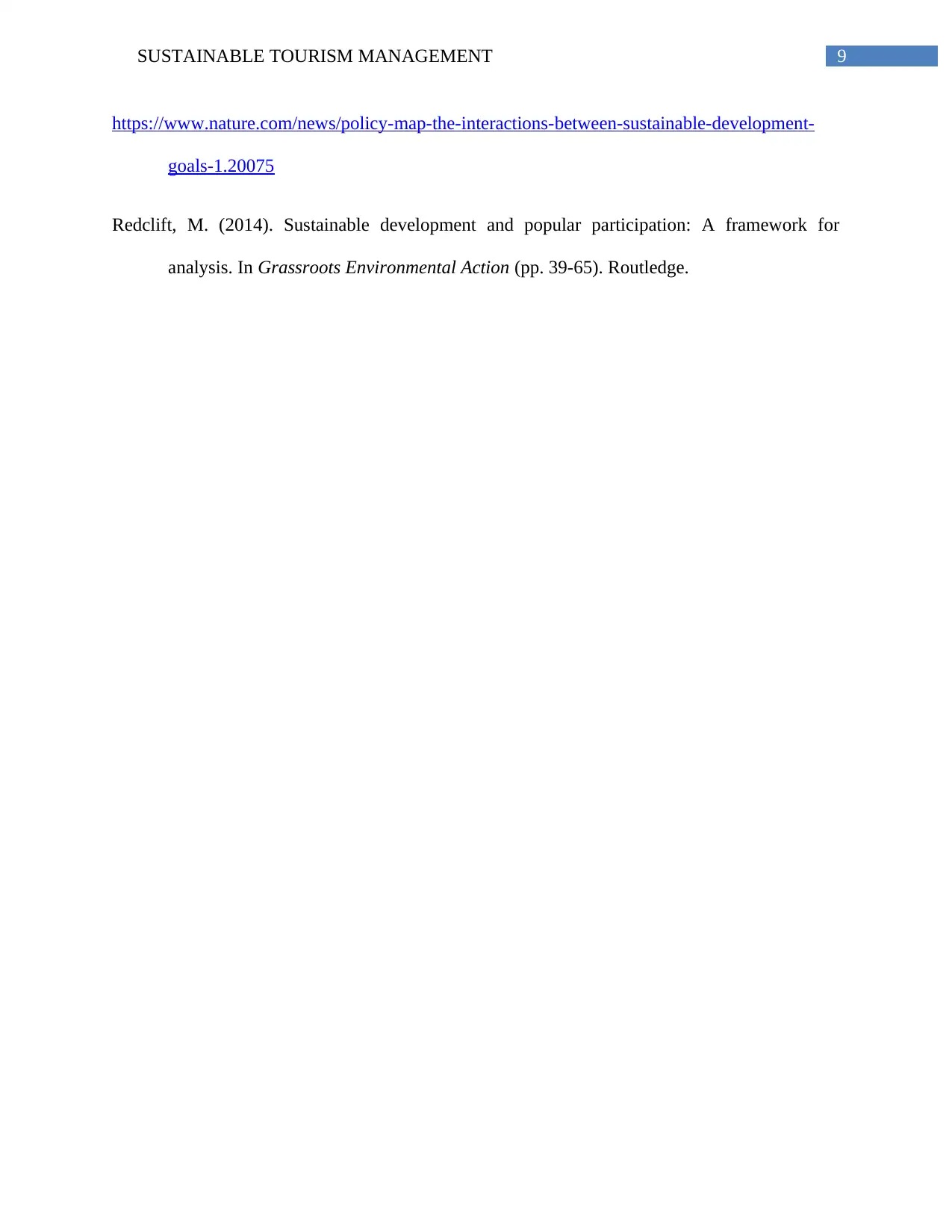
9SUSTAINABLE TOURISM MANAGEMENT
https://www.nature.com/news/policy-map-the-interactions-between-sustainable-development-
goals-1.20075
Redclift, M. (2014). Sustainable development and popular participation: A framework for
analysis. In Grassroots Environmental Action (pp. 39-65). Routledge.
https://www.nature.com/news/policy-map-the-interactions-between-sustainable-development-
goals-1.20075
Redclift, M. (2014). Sustainable development and popular participation: A framework for
analysis. In Grassroots Environmental Action (pp. 39-65). Routledge.
Paraphrase This Document
Need a fresh take? Get an instant paraphrase of this document with our AI Paraphraser

10SUSTAINABLE TOURISM MANAGEMENT
Bibliography
https://www.ecotourism.org.au/membership/members-of-ecotourism-australia/protected-area-
managers-members/the-great-barrier-reef-marine-park-authority/
https://greatbarrierreef.com.au/responsibletourism/
http://www.bbc.com/travel/story/20110112-travelwise-sustainable-travel-in-malaysia
https://www.frommers.com/destinations/malaysia/planning-a-trip/sustainable-travel--ecotourism
https://www.nationalgeographic.com/travel/destinations/asia/bhutan/carbon-negative-country-
sustainability/
https://www.tourism.net.nz/visitor-information/maori-tourism
Bibliography
https://www.ecotourism.org.au/membership/members-of-ecotourism-australia/protected-area-
managers-members/the-great-barrier-reef-marine-park-authority/
https://greatbarrierreef.com.au/responsibletourism/
http://www.bbc.com/travel/story/20110112-travelwise-sustainable-travel-in-malaysia
https://www.frommers.com/destinations/malaysia/planning-a-trip/sustainable-travel--ecotourism
https://www.nationalgeographic.com/travel/destinations/asia/bhutan/carbon-negative-country-
sustainability/
https://www.tourism.net.nz/visitor-information/maori-tourism
1 out of 11
Related Documents
Your All-in-One AI-Powered Toolkit for Academic Success.
+13062052269
info@desklib.com
Available 24*7 on WhatsApp / Email
![[object Object]](/_next/static/media/star-bottom.7253800d.svg)
Unlock your academic potential
Copyright © 2020–2026 A2Z Services. All Rights Reserved. Developed and managed by ZUCOL.





